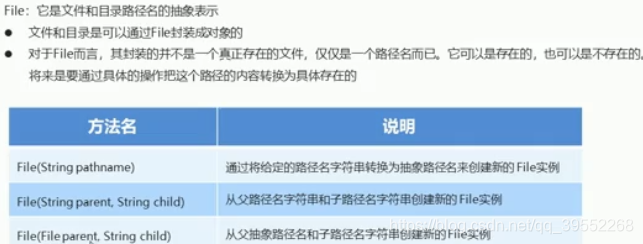java File类的相关操作
本文共 527 字,大约阅读时间需要 1 分钟。
1.File类概述和构造方法
windows系统
- 一个点表示当前目录 直接写文件名字也是如此
- 两个点表示上级目录

注意第三个构造方法 父为对象 子为路径名

直接输出File对象会输出文件的绝对路径因为File类改写了toString()方法,输出时会自动调用
这三个构造方法做了同样的事情
2.File类的创建方法


f4.mkdir()会创建一个名字为javase.txt的文件 如果这时再调用 f4.createNewFile会报false因为已经存在一个名字为javase.txt的目录,在这里目录就是文件的意思 mkdirs只能创建多层目录,如果想创建多层目录+txt文件就用mkdirs+creatNewFile

3.绝对路径和相对路径

4.delete和实例

如果一个文件下有内容,则不能直接删除此文件
5.File常用方法
 、
、

//抽象路径名 绝对路径名和 规范路径名的区别
file.list获取当前文件下的目录或文件的名字
就等于f2.listFiles()方法获取当前目录下所有文件和目录对象后在分别调用他们的getName()方法,但这个方法的好处就是可以通过文件对象来进行各种额外的判断操作如上面展示的
递归遍历一个目录下的所有文件

转载地址:http://ymsi.baihongyu.com/
你可能感兴趣的文章
Nginx安装及配置详解
查看>>
Nginx实战经验分享:从小白到专家的成长历程!
查看>>
Nginx实现反向代理负载均衡
查看>>
nginx实现负载均衡
查看>>
nginx开机启动脚本
查看>>
nginx异常:the “ssl“ parameter requires ngx_http_ssl_module in /usr/local/nginx/conf
查看>>
nginx总结及使用Docker创建nginx教程
查看>>
nginx报错:the “ssl“ parameter requires ngx_http_ssl_module in /usr/local/nginx/conf/nginx.conf:128
查看>>
nginx报错:the “ssl“ parameter requires ngx_http_ssl_module in usrlocalnginxconfnginx.conf128
查看>>
nginx日志分割并定期删除
查看>>
Nginx日志分析系统---ElasticStack(ELK)工作笔记001
查看>>
Nginx映射本地json文件,配置解决浏览器跨域问题,提供前端get请求模拟数据
查看>>
nginx最最最详细教程来了
查看>>
Nginx服务器---正向代理
查看>>
Nginx服务器上安装SSL证书
查看>>
Nginx服务器的安装
查看>>
Nginx模块 ngx_http_limit_conn_module 限制连接数
查看>>
nginx添加模块与https支持
查看>>
Nginx用户认证
查看>>
Nginx的location匹配规则的关键问题详解
查看>>